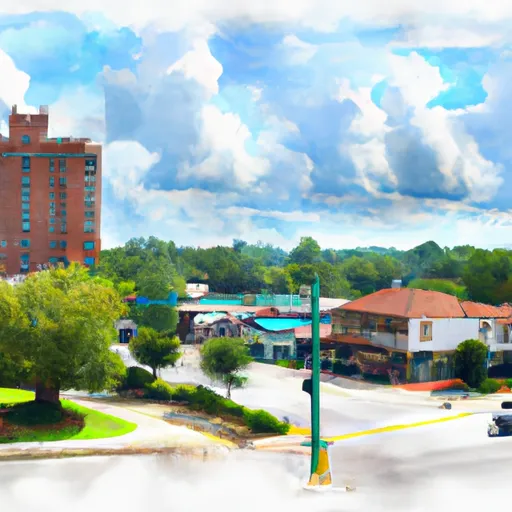-
 Snoflo Premium
Snoflo Premium
Get unlimited access to all our content
With no Ad interruptions! - Start Your Free Trial Login with existing account
Sumterville
Eden Index
Climate
7.1
•
Recreation
5.9
•
Community
•
Safeguard
4.9/10

Sumterville, Florida is a small town located in Sumter County, in the central part of the state. The town has a warm and humid climate, typical of the region, with long, hot summers and mild winters. Average summer temperatures range from the 80s to the 90s°F, while winter temperatures range from the 50s to 70s°F.
As for hydrology constituents, Sumterville is part of the larger Floridan Aquifer System, which provides a significant portion of Florida's freshwater supply. The aquifer is composed of limestone and provides water for domestic, agricultural, and industrial use.
Outdoor recreation enthusiasts will find plenty of opportunities in Sumterville and its surrounding areas. The town is located near Lake Panasoffkee, which offers various activities such as boating, fishing, and wildlife watching. The nearby Withlacoochee State Forest provides opportunities for hiking, camping, and horseback riding. Additionally, the area is known for its numerous golf courses, offering opportunities for golf enthusiasts.
In conclusion, Sumterville, Florida offers a warm and humid climate, is part of the Floridan Aquifer System, and provides various outdoor recreational opportunities, from water-based activities on Lake Panasoffkee to hiking in Withlacoochee State Forest and golfing.
What is the Eden Index?
The Snoflo Eden Index serves as a comprehensive rating system for regions, evaluating their desirability through a holistic assessment of climate health, outdoor recreation opportunities, and natural disaster risk, acknowledging the profound impact of these factors on livability and well-being.
Climate Health Indicator (CHI): 7.1
Sumterville receives approximately
1290mm of rain per year,
with humidity levels near 88%
and air temperatures averaging around
22°C.
Sumterville has a plant hardyness factor of
9, meaning
plants and agriculture in this region tend to thrive here all year round.
By considering the ideal temperature range, reliable water supplies, clean air, and stable seasonal rain or snowpacks, the Climate Health Indicator (CHI) underscores the significance of a healthy climate as the foundation for quality living.
A healthy climate is paramount for ensuring a high quality of life and livability in a region, fostering both physical well-being and environmental harmony. This can be characterized by ideal temperatures, reliable access to water supplies, clean air, and consistent seasonal rain or snowpacks.
Weather Forecast
Streamflow Conditions
Tampa Bay
Area Rivers
Tampa Bay
Snowpack Depths
Tampa Bay
Reservoir Storage Capacity
Tampa Bay
Groundwater Levels
Recreational Opportunity Index (ROI): 5.9
The Recreational Opportunity Index (ROI) recognizes the value of outdoor recreational options, such as parks, hiking trails, camping sites, and fishing spots, while acknowledging that climate plays a pivotal role in ensuring the comfort and consistency of these experiences.
Access to outdoor recreational opportunities, encompassing activities such as parks, hiking, camping, and fishing, is crucial for overall well-being, and the climate plays a pivotal role in enabling and enhancing these experiences, ensuring that individuals can engage in nature-based activities comfortably and consistently.
Camping Areas
| Campground | Campsites | Reservations | Toilets | Showers | Elevation |
|---|---|---|---|---|---|
| Edward Medard | None | 79 ft | |||
| Silver Lake - Withlacoochee State Forest | 23 | 78 ft | |||
| Hog Island - Withlacoochee State Forest | 20 | 72 ft | |||
| Hillsborough River State Park | None | 58 ft | |||
| Crooked River - Withlacoochee State Forest | 26 | 72 ft | |||
| River Jct - Withlacoochee State Forest | 20 | 67 ft | |||
| Saddle Creek County Park | None | 111 ft | |||
| Withlacoochee River Park | 10 | 94 ft | |||
| Alafia River State Park | None | 117 ft | |||
| Lithia Springs | None | 51 ft |
Catastrophe Safeguard Index (CSI):
The Catastrophe Safeguard Index (CSI) recognizes that natural disaster risk, encompassing floods, fires, hurricanes, and tornadoes, can drastically affect safety and the overall appeal of an area.
The level of natural disaster risk in a region significantly affects safety and the overall livability, with climate change amplifying these risks by potentially increasing the frequency and intensity of events like floods, fires, hurricanes, and tornadoes, thereby posing substantial challenges to community resilience and well-being.
Community Resilience Indicator (CRI):
The Community Resilience Indicator (CRI) recognizes that education, healthcare, and socioeconomics are crucial to the well-being of a region. The CRI acknowledges the profound impact of these elements on residents' overall quality of life. By evaluating educational resources, healthcare accessibility, and economic inclusivity, the index captures the essential aspects that contribute to a thriving community, fostering resident satisfaction, equity, and social cohesion.

